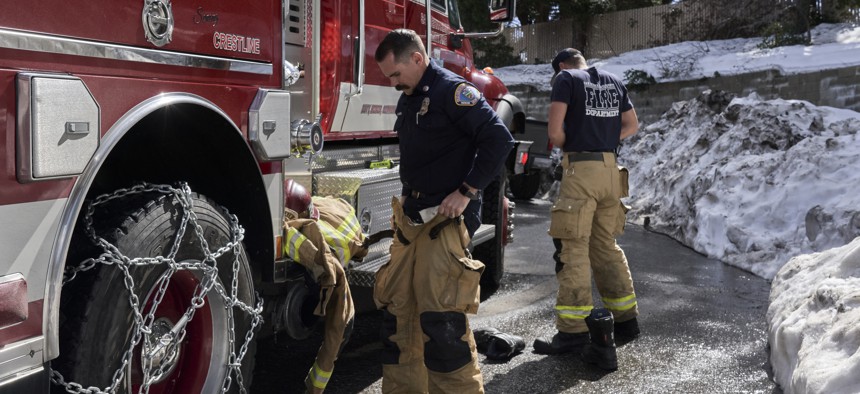Celebrating Public Service—and Public Servants

A series of storms this spring dumped snow that trapped residents and damaged buildings in communities in the San Bernardino Mountains. Philip Cheung for The Washington Post via Getty Images
COMMENTARY | Government is asked to solve our toughest and most intractable problems. That’s why we need to celebrate the people who make a difference through government service.
This week is Public Service Recognition Week. Since 1985, the first full week in May has been the annual celebration of the contributions of public servants in federal, state, local and tribal government. Across the nation, more than 21 million dedicated people serve in government, including in our public schools and universities.
During the pandemic, these public servants continued to do their jobs quietly and effectively, including serving on the front lines in the battle against the coronavirus. Many of the health care professionals who courageously and selflessly cared for Covid-19 patients were government employees. Other public servants continued to protect our nation and our communities, fight fires, operate public transportation, preserve the environment, provide social services, deliver mail, and maintain our public facilities and infrastructure.
These dedicated people risked their health, and in some cases their lives, to serve people across the nation, including many of the most vulnerable members of society. Other government employees delivered essential services behind the scenes, less visibly but just as importantly.
Now, as we emerge from the pandemic, public servants continue to serve Americans despite a workforce crisis in government. While the U.S. private sector has recovered the jobs lost during the pandemic, the public sector lags behind. A Washington Post op-ed piece last year declared, “A slow-moving crisis is paralyzing states and cities.” Some would dispute that it is slow-moving.
In March, there were 922,000 vacancies in state and local government but only 350,000 hires. A recent national survey revealed that 59 percent of state and local government employees are considering changing jobs or leaving the workforce entirely. And 77 percent say that high employee turnover has put a strain on their own workloads.
Despite the workforce crisis, public servants persevere in delivering essential services.
Their dedication stands in sharp contrast to what are too often heated budget battles and rhetoric about the size, function, scope and effectiveness of government. This debate frequently generates harsh—and usually unjustified—criticism of the public servants who deliver essential services.
This is regrettable because we continue to ask the government to solve some of our nation’s toughest and most intractable problems. Americans expect the government to protect our nation and our communities, maintain a strong economy, preserve our quality of life, reduce poverty and homelessness, recover from disasters, safeguard the environment, educate our children, ensure affordable health care, and play a leadership role in creating an equitable, inclusive, and diverse society.
To meet these difficult challenges, the government must attract, develop, and retain talented and committed employees. This is becoming more difficult.
Public service used to be a highly respected profession—described as a “noble calling” by President George H. W. Bush. The best and brightest aspired to make a difference through government service—in Washington, D.C., in their state capitals and in their local communities.
To revive this excitement about working in government, it is important to celebrate public service and public servants. The career employees I have encountered in my almost 50 years working in and with all levels of government don’t want awards, big salaries or hefty bonuses.
They simply want to make a difference.
And they do make a difference, day in and day out. These public servants also want the people they serve to understand and appreciate the contributions the government makes to our nation, our states and our communities.
It is especially fitting during Public Service Recognition Week that we acknowledge and celebrate these contributions. But we should do this year-round.
Bob Lavigna, author of the book Engaging Government Employees, is director of the Institute for Public Sector Employee Engagement, a division of CPS HR Services, an independent government agency.
NEXT STORY: New State Efforts to Address Workforce Shortages





